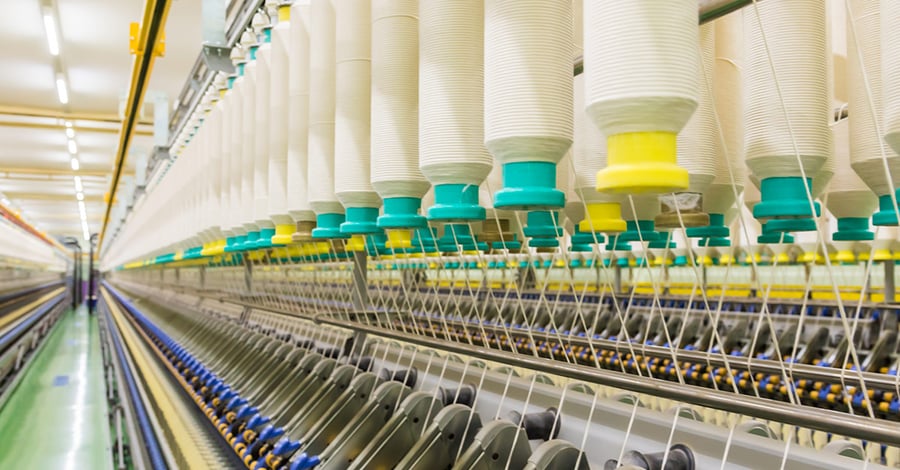

In the intricate world of textile manufacturing, every thread counts. From the initial stages of yarn production to the final weaving of fabric, efficiency is paramount for success. Among the numerous tools at the disposal of textile manufacturers, the Enterprise Resource Planning (ERP) system stands out as a game-changer, particularly in optimizing spinning efficiency. Let's delve into how textile ERP solutions are revolutionizing the spinning process, maximizing productivity, and ensuring profitability in textile manufacturing.
Understanding Spinning Efficiency
Spinning, the process of converting raw fibers into yarn, is a pivotal function in textile manufacturing. Spinning efficiency refers to the ability to produce high-quality yarn with minimal waste generation and downtime. Factors such as machine utilization, raw material optimization, labor efficiency, and production planning significantly influence spinning efficiency.
Challenges to Spinning Efficiency
Traditionally, textile manufacturers grapple with several challenges in optimizing spinning efficiency:
-
Complex Supply Chains:
While bale is the key raw material, spinning involves several other raw materials. Managing their sources and suppliers adds complexity to the spinning process. -
Inventory Management:
Balancing raw material inventory levels to meet production demands while minimizing holding costs is a delicate task. -
Production Planning:
Synchronizing machine capacity with demand forecasts and production schedules requires meticulous planning and coordination. -
Quality Control:
Ensuring consistent yarn quality with minimal defects is crucial for meeting customer specifications.
The Role of Textile ERP Software
An ideal ERP solution offers a comprehensive suite of tools to address these challenges and enhance spinning efficiency:
Integrated Supply Chain Management:
Get visibility across the entire supply chain, from raw material procurement to yarn production. Through this integration, textile ERP enables efficient inventory management and reduces lead times.
Real-time Monitoring and Analytics:
Textile ERP software offers real-time monitoring of machine performance, production output, and quality metrics through 3rd party integration (like weighbridge, HVI, USTER, and CASCADE integrations). Advanced analytics capabilities help identify inefficiencies and opportunities for improvement in efficiency and qualify.
Production Planning and Scheduling:
Textile ERP systems facilitate optimized production planning and scheduling by considering factors such as machine capacity, raw material availability, and customer demand. This is often achieved through a dedicated feature called Spin Plan or Spindle Plan. This comprehensive approach ensures efficient resource utilization, minimizing downtime and maximizing production output.
Quality Assurance:
Improve quality through integrated quality management modules present in textile ERP software. These modules track yarn quality at every stage of the spinning process, allowing for prompt identification and correction of any issues. This proactive approach, often aided by features like "Deviation Alert Emails," minimizes rework and ensures consistent yarn quality, ultimately boosting customer satisfaction.
Cost Control:
Manufacturers get access to real-time insights into production costs upon using textile ERP. This transparency enables them to identify areas for cost savings and optimize resource allocation. Features like "Cost Analysis" for every inquiry provide accurate estimations, while functionalities like "Cost vs. Actual Comparison" reveal variances between projected and actual costs. This comprehensive cost management approach helps manufacturers make informed decisions and improve profitability.
Benefits of ERP Services in Spinning Efficiency
Implementing textile ERP solutions in spinning operations yields several benefits:
-
Increased Productivity:
Streamlined processes, optimized production schedules, and reduced downtime result in higher productivity and output. Automation of processes can reduce cycle times by up to 90%. -
Improved Quality:
Enhanced quality control mechanisms ensure consistent yarn quality, reducing defects and customer complaints. -
Cost Reduction:
By optimizing inventory levels, minimizing waste, and improving resource utilization, textile ERP solutions help lower production costs and increase profitability. Consider inbound logistics. Every day, trucks deliver tons of bales to the spinning facility, and the quantity and quality significantly impact downstream processes. A manual entry error at the weighbridge, missing the actual weight by 100 kg, can result in a loss of up to USD 500 or Rs. 36,000 per bale. These losses can add up on a large scale. Having software to automate and monitor processes can reduce overall costs significantly. -
Enhanced Decision-Making:
Real-time data analytics empower decision-makers with actionable insights, enabling continuous improvement and adaptation to changing market dynamics.
Leveraging Cloud ERP Solutions for Enhanced Spinning Efficiency
The textile industry is increasingly adopting Cloud ERP solutions to streamline spinning operations and optimize efficiency. Unlike traditional on-premise systems, a Cloud ERP system provides real-time access to critical production data, ensuring seamless coordination between inventory management, production planning, and quality control.
One of the biggest advantages of Cloud ERP solutions in spinning operations is their ability to integrate with modern textile technologies such as IoT-enabled machinery, automated weighbridges, and advanced quality monitoring tools like HVI and USTER. This integration allows manufacturers to monitor machine performance, predict maintenance needs, and minimize downtime—key factors in maintaining optimal spinning efficiency.
Additionally, a Cloud ERP system offers enhanced scalability and flexibility. Spinning mills can easily adjust their production schedules based on demand forecasts, optimize raw material procurement, and automate stock replenishment. The centralized nature of Cloud ERP solutions ensures that all departments, from procurement to production and sales, work with synchronized data, reducing inefficiencies and errors.
With built-in analytics and reporting features, ERP solutions empower decision-makers with actionable insights. Whether it's tracking spindle utilization rates, analyzing production costs, or improving labor efficiency, a robust ERP system helps textile manufacturers make data-driven decisions that enhance productivity and profitability.
By implementing Cloud ERP solutions, textile businesses can gain a competitive edge, ensuring consistent yarn quality, optimized resource utilization, and cost-effective operations in an increasingly dynamic market.
Case Study: How Super Sales India Limited Improved Efficiency and Savings with Textile ERP
Super Sales India Limited (SSIL) Textile division, a leading textile manufacturer, implemented a textile ERP system to optimize spinning efficiency. By integrating production planning, inventory management, and quality control processes, SSIL achieved a 20% increase in spinning productivity and a 15% reduction in production costs within the first year of implementation. Real-time monitoring and analytics capabilities enabled proactive decision-making, further enhancing operational efficiency and competitiveness.
Conclusion
In the competitive landscape of textile manufacturing, spinning efficiency is the cornerstone of success. ERP solutions offer a comprehensive approach to maximizing productivity, optimizing resource utilization, and ensuring quality in the spinning process. By harnessing the power of textile ERP, textile manufacturers can gain a crucial efficiency edge, ensuring they consistently meet customer demands and achieve sustainable growth in the ever-evolving textile industry.
Frequently Asked Questions (FAQs)
Enterprise asset management (EAM) involves the management of mission critical assets of an organization throughout each asset's lifecycle. EAM is used to plan, optimize, execute, and track the needed maintenance activities with the associated priorities, skills, materials, tools, and information. The aim is to optimize the quality and utilization of assets throughout their lifecycle, increase productive uptime and reduce operational costs.
Enterprise asset management (EAM) involves the management of the maintenance of physical assets of an organization throughout each asset's lifecycle. EAM is used to plan, optimize, execute, and track the needed maintenance activities with the associated priorities, skills, materials, tools, and information.
The software helps in effective maintenance of assets through preventive, predictive, shutdown and breakdown maintenance strategies. The system also helps enterprises mitigate equipment risks by enhanced safety standards. The streamlined operations and improved asset performance helps organizations increase their investment effectiveness.
EAM is important because it helps organizations track, assess, manage and optimize asset quality and reliability. Asset intensive Organizations have hundreds, thousands, even millions of assets which needs to be maintained to maximize / optimize life of these assets to increase the return on investment.
The key features of effective EAM are:
- Work management.
- Maintenance Strategies (Preventive/ Predictive / Breakdown / Shutdown).
- Planning and scheduling.
- Supply chain management.
- Health and safety.
- Mobility.
- Analytics.
- Improved Asset Health at reduced cost through data driven maintenance Programs
- Complete visibilityon entire maintenance data across Equipment, across Models, across Branches to aid in analysis & decision making such as to Repair or Replace the Equipment
- Insightful analysis of Inspection Data to improve customer satisfaction
- Effective maintenance management enhanced by predictive maintenance and inbuilt analytics
- Increased reliability and safety, keeps complete track of all the inspections & calibration schedules
- Mobile Application enables users to execute work while “in the field” leading to minimized non-productive time and increased productivity and reduces duplication of work and human errors in recording information.
- Quick turnaround time through Actionable Notification & Alerts for every process in real time and accessible anytime and anywhere.
- Improved Regulatory Part of asset management involves the implementation of better O&M practices, which can significantly improve compliance.
Asset Intensive companies under the following Industries :
- Ports
- Cement and Mining
- Utilities
- Fleet Maintenance
- Equipment Rental
- Other Manufacturing
- Real Estate & Infrastructure
- Power Generation
Contact us for a meeting and schedule a demo
This differs on case to case basis, based on the type of installation and unique industry specific requirements. Contact us for a meeting and schedule a demo.
This differs on case to case basis, based on the type of installation and unique industry specific requirements. Contact us for a meeting and schedule a demo.
Stay Connected, follow us on LinkedIn / Twitter to know more about EAM Software latest trends.


